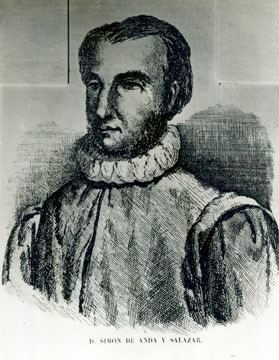Battles/wars Seven Years' War Succeeded by Pedro de Sarrio | ||
 | ||
Born October 28, 1709Subijana, Basque Country, Spain ( 1709-10-28 ) Died 30 October 1776, Cavite, Philippines | ||
Simón de Anda y Salazar (October 28, 1709 – October 30, 1776) was a Spanish Basque governor of the Philippines from July, 1770 to October 30, 1776.
Contents
Oidor at the Royal Audience of Manila and Lieutenant Governor
De Anda y Salazar was an Oidor of the Royal Audience of Manila, who was appointed as Lieutenant Governor of the city by the Governor-General of the Philippines and the Audiencia itself during the British occupation of Manila. He departed Manila on the night of 5 Oct. 1762, during the Battle of Manila (1762), and established Spanish resistance in Bulacan. The acting governor of Manila, Archbishop Manuel Rojo, was captured by the British resulting in the surrender of Manila and Cavitie.
Resistance Movement
Anda organized resistance against the invaders and assumed military power on behalf of the Real Audiencia. All early negotiations between him and the British forces proved unsuccessful, as he returned unopened all letters sent to him that did not address him as the legitimate Governor-General of the Philippines, something that the British refused to do until the death of Archbishop Rojo, on January 30, 1764.
Anda's forces successfully took control of the countryside, suppressed British backed revolts, and forced the British into the defensive in Manila. In March 1764, orders were brought from both the King of the United Kingdom and the King of Spain by governor designate Brigadier Don Francisco de la Torre, requiring the handover of the city to Spain in accordance with the Treaty of Paris (1763). British Governor Drake was charged with culpability as governor but forestalled an adverse finding by resigning and leaving the Philippines on March 29, 1764. The Manila Council elected Alexander Dalrymple as governor on the same day, but the Manila garrison would not obey him. On April 1, 1764, the Manila garrison ceremonially marched out, embarking for home, and giving the Spanish control of Manila with de la Torre as Governor and Captain-General of the Spanish Philippines.
Governor-General of the Philippines
Anda traveled to Spain, and was well received by the Cortes Generales (parliament), and made Councilor of Castile by the King, in spite of having written a letter to him complaining of certain disorders in the Philippines, enumerating among them a number against the friars.
On April 12, 1768, he returned to the Philippines and by Royal Decree became Governor-General in July 1770. He proceeded against his predecessor, and other politicians, and roused the opposition and reformed the Spanish and Philippine army, and engaged in other public works. He opposed the king's order of November 9, 1774, to secularize the curacies held by regulars. After his death, the order was repealed on 11 December 1776.
De Anda y Salazar died on 30 October 1776, in the Hospital de San Felipe, in Cavite at the age of 67 years.
Legacy
A monument to his legacy was erected on Bonifacio Drive in Manila, and the municipalities of San Simon in Pampanga, Anda in Bohol and Anda in Pangasinan were named after him. A street has also been named after him in the Basque capital of Vitoria, close to his natal town of Subijana.
